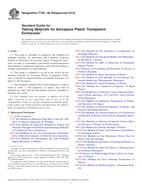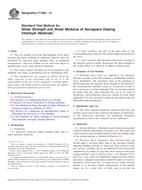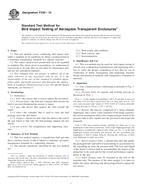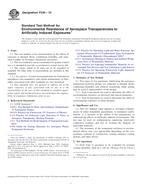Wir benötigen Ihre Einwilligung zur Verwendung der einzelnen Daten, damit Sie unter anderem Informationen zu Ihren Interessen einsehen können. Klicken Sie auf "OK", um Ihre Zustimmung zu erteilen.
ASTM F790-08(2013)
Standard Guide for Testing Materials for Aerospace Plastic Transparent Enclosures
Automatische name übersetzung:
Standard-Leitfaden zur Prüfung Materialien für Luft- und Raumfahrt Kunststoff Transparent Gehäuse
NORM herausgegeben am 1.12.2013
Informationen über die Norm:
Bezeichnung normen: ASTM F790-08(2013)
Anmerkung: UNGÜLTIG
Ausgabedatum normen: 1.12.2013
SKU: NS-56448
Zahl der Seiten: 3
Gewicht ca.: 9 g (0.02 Pfund)
Land: Amerikanische technische Norm
Kategorie: Technische Normen ASTM
Kategorie - ähnliche Normen:
Die Annotation des Normtextes ASTM F790-08(2013) :
Keywords:
abrasion, acrylic, adhesion, aerospace, bonding, electrical, enclosures, environmental, impact, interlayers, materials, mechanical, optical, physical, plastic, polycarbonate, properties, thermal, transparent, ICS Number Code 49.045 (Structure and structure elements)
Ergänzende Informationen
| Significance and Use | |
|
3.1 This guide is intended for use by material suppliers, aircraft transparent enclosure fabricators, air-frame manufacturers, government agencies, and others that may become involved in the testing of transparency components. These test methods provide data on both individual materials and material combinations commonly utilized in the fabrications of aerospace transparent enclosures comprised of monolithic plastic, coated monolithic plastic or laminated constructions containing plastics. 3.2 Primary properties and their long term stability are critical to the performance of aerospace transparent enclosures. Property measurement tests define as-manufactured material properties of these materials. Aging procedures provide for exposure of parts or representative sections to environments that may induce changes in material properties as determined in property measurement tests. Property measurement tests performed before and after aging exposure provide a means of estimating the potential usable life span of a transparency or to compare the durability of one material with another. 3.3 When employing these test methods for comparison of materials for weathering effects the user should be aware that the many factors influencing degradation due to weathering vary from one location to another. For direct weathering comparisons, all material(s) should undergo exposure conditions and property measurements testing at the same time. 3.4 The test methods listed include those considered critical to the performance of aircraft transparent enclosures. Other test methods to evaluate materials may also be performed. Additional test methods are in preparation and will be incorporated. The user is advised to employ the latest revision of any test method. 3.5 The dominant component of all transparent enclosures is one, or more, rigid transparent sheet(s). The sheet(s) must permit the necessary visibility while providing structural integrity and protecting the aircraft interior from external environments as required by the specific aircraft design. 3.6 In its most simple form, the rigid transparent sheet may be the only component of a transparent enclosure. 3.7 When more than one rigid transparent sheet is employed, the sheets are laminated with a controlled thickness with either an air gap or with a transparent adhesive known as an interlayer. 3.8 Transparent enclosure designs may use multiple rigid transparent sheets to take advantage of specific properties of different materials. In this instance, there will be functions required of one of the sheets but not the other. 3.9 The test methods, practices and guides listed are a summary of the available test methods applicable to plastic transparent enclosures. They are presented in this format to simplify the search and to enable the user to determine if a method applicable to his requirements is available. |
|
| 1. Scope | |
|
1.1 This guide is intended to summarize the standard test methods available on individual and composite materials utilized in fabrication of aerospace plastic transparent enclosures. As such, it is intended to specifically include transparent thermoplastics, transparent elastomers, and reinforced plastics, whether thermoplastic or thermosetting. 1.2 This guide is intended as an aid in the search for test methods pertinent to Aerospace Plastic Transparent Enclosures. It should be understood that all methods listed may not apply to all enclosures. 1.3 The standards included refer to the properties or aspects listed in Table 1. The properties or aspects are listed in alphabetical order and the descriptions used are intended to facilitate the search. Property or Aspect |
Test Method |
|
Abrasion Resistance |
D1044 |
|
Abrasion Resistance—Oscillating Sand |
F735 |
|
Abrasion Testing—Sizing Sand for |
C117 |
|
Bearing Strength |
D953 |
|
Bird Impact Resistance |
F330 |
|
Bond Integrity |
F521 |
|
Brittleness Temperature—By Impact |
D746 |
|
Chemical Resistance |
D543 |
|
Coefficient of Linear Thermal Expansion |
D696 |
|
Compressive Properties |
D695 |
|
Electrical Insulating Material—DC Resistance or Conductance |
D257 |
|
Electrical Insulating Material—Dielectric Breakdown Voltage |
D149 |
|
Electrical Insulating Material—Dielectric Constant |
D150 |
|
Electrical Insulating Material—Flexural Properties |
D790 |
|
Electrical Insulating Material—Impact Resistance |
D256 |
|
Electrical Insulating Material—Rockwell Hardness |
D785 |
|
Environmental Resistance |
F520 |
|
Exposure Apparatus Operation—Carbon ARC Type |
D1499 |
|
Exposure Apparatus Operation—Fluorescent UV Type |
G154 |
|
Exposure Apparatus Operation—Xenon ARC Type |
D2565 |
|
Flow Rate |
D1238 |
|
Glass Transition Temperature |
E1640 |
|
Hail Impact Resistance |
F320 |
|
Hardness—Barcol |
D2583 |
|
Hardness—Durometer |
D2240 |
|
Heating Elements—Detection of Flaws |
F319 |
|
Ignition Loss |
D2584 |
|
Impact Resistance—Falling Weight |
D5420 |
|
Impact Resistance—Falling Weight (Polycarbonate) |
F736 |
|
Index of Refraction |
D542 |
|
Interlayer Material Selection |
F942 |
|
Light Transmissivity |
F1316 |
|
Luminous Transmittance and Haze |
D1003 |
|
Optical Angular Deviation |
F801 |
|
Optical Angular Displacement—Multiple Images |
F1165 |
|
Optical Binocular Disparity |
F1181 |
|
Optical Distortion and Deviation—Double Exposure |
F733 |
|
Optical Reflectivity |
F1252 |
|
Peel Resistance—Floating Roller |
D3167 |
|
Rubber Properties in Tension |
D412 |
|
Scratches—Intensity of |
F548 |
|
Shear Strength—Fusion Bonded Polycarbonate |
F734 |
|
Shear Strength and Modulus—Interlayer Materials |
F1362 |
|
Softening Temperature |
D1525 |
|
Specific Gravity and Density |
D792 |
|
Specific Heat |
D2766 |
|
Stress Crazing |
F791 |
|
Stress Crazing |
F484 |
|
Tear Resistance |
D624 |
|
Tear Resistance—Initial |
D1004 |
|
Tensile Properties |
D638 |
|
Water Absorption |
D570 |
1.4 This standard does not purport to address all of the safety concerns, if any, associated with its use. It is the responsibility of the user of this standard to establish appropriate safety and health practices and determine the applicability of regulatory limitations prior to use.
|
Standard Test Method for Intensity of Scratches on Aerospace Transparent Plastics |
|
|
Standard Test Method for Impact Resistance of Flat, Rigid Plastic Specimen by Means of a Striker Impacted by a Falling Weight (Gardner Impact) |
|
|
Standard Test Method for Measuring Optical Angular Deviation of Transparent Parts |
|
|
Standard Guide for Selection of Test Methods for Interlayer Materials for Aerospace Transparent Enclosures (Includes all amendments and changes 6/7/2023). |
|
|
Standard Test Method for Measuring Angular Displacement of Multiple Images in Transparent Parts |
|
|
Standard Test Method for Measuring Binocular Disparity in Transparent Parts |
|
|
Standard Practice for Optical Distortion and Deviation of Transparent Parts Using the Double-Exposure Method |
|
|
Standard Test Method for Shear Strength of Fusion Bonded Polycarbonate Aerospace Glazing Material |
|
|
Standard Test Method for Abrasion Resistance of Transparent Plastics and Coatings Using the Oscillating Sand Method |
|
|
Standard Test Method for Impact Resistance of Monolithic Polycarbonate Sheet by Means of a Falling Weight |
|
|
Standard Test Method for Stress Crazing of Transparent Plastics |
|
|
Standard Test Method for Measuring the Transmissivity of Transparent Parts |
|
|
Standard Test Method for Shear Strength and Shear Modulus of Aerospace Glazing Interlayer Materials |
|
|
Standard Practice for Operating Fluorescent Ultraviolet (UV) Lamp Apparatus for Exposure of Materials |
|
|
Standard Test Method for Assignment of the Glass Transition Temperature By Dynamic Mechanical Analysis |
|
|
Standard Test Method for Coefficient of Linear Thermal Expansion of Plastics Between -30°C and 30°C with a Vitreous Silica Dilatometer |
|
|
Standard Test Method for Brittleness Temperature of Plastics and Elastomers by Impact |
|
|
Standard Test Method for Rockwell Hardness of Plastics and Electrical Insulating Materials |
|
|
Standard Test Methods for Flexural Properties of Unreinforced and Reinforced Plastics and Electrical Insulating Materials |
|
|
Standard Test Methods for Density and Specific Gravity (Relative Density) of Plastics by Displacement |
|
|
Standard Test Method for Pin-Bearing Strength of Plastics |
|
|
Standard Test Method for Haze and Luminous Transmittance of Transparent Plastics |
|
|
Standard Test Method for Tear Resistance (Graves Tear) of Plastic Film and Sheeting |
|
|
Standard Test Method for Resistance of Transparent Plastics to Surface Abrasion by the Taber Abraser |
|
|
Standard Test Method for Melt Flow Rates of Thermoplastics by Extrusion Plastometer (Includes all amendments and changes 12/6/2023). |
|
|
Standard Test Method for Index of Refraction of Transparent Organic Plastics |
|
|
Standard Practices for Evaluating the Resistance of Plastics to Chemical Reagents |
|
|
Standard Test Method for Water Absorption of Plastics |
|
|
Standard Test Method for Tear Strength of Conventional Vulcanized Rubber and Thermoplastic Elastomers |
|
|
Standard Test Method for Tensile Properties of Plastics |
|
|
Standard Test Method for Compressive Properties of Rigid Plastics |
|
|
Standard Test Methods for AC Loss Characteristics and Permittivity (Dielectric Constant) of Solid Electrical Insulation |
|
|
Standard Test Methods for Determining the Izod Pendulum Impact Resistance of Plastics (Includes all amendments and changes 4/7/2023). |
|
|
Standard Test Methods for DC Resistance or Conductance of Insulating Materials (Includes all amendments and changes 5/6/2021). |
|
|
Standard Test Method for Materials Finer than 75-?m (No. 200) Sieve in Mineral Aggregates by Washing |
|
|
Standard Test Methods for Vulcanized Rubber and Thermoplastic Elastomers—Tension |
|
|
Standard Test Method for Dielectric Breakdown Voltage and Dielectric Strength of Solid Electrical Insulating Materials at Commercial Power Frequencies |
|
|
Standard Practice for Polarized Light Detection of Flaws in Aerospace Transparency Heating Elements |
|
|
Standard Test Method for Hail Impact Resistance of Aerospace Transparent Enclosures |
|
|
Standard Test Method for Bird Impact Testing of Aerospace Transparent Enclosures |
|
|
Standard Test Method for Stress Crazing of Acrylic Plastics in Contact with Liquid or Semi-Liquid Compounds |
|
|
Standard Test Method for Environmental Resistance of Aerospace Transparencies to Artificially Induced Exposures |
|
|
Standard Test Methods for Bond Integrity of Transparent Laminates |
|
|
Standard Practice for Filtered Open-Flame Carbon-Arc Exposures of Plastics |
|
|
Standard Test Method for Vicat Softening Temperature of Plastics (Includes all amendments and changes 9/15/2017). |
|
|
Standard Test Method for Rubber Property—Durometer Hardness |
|
|
Standard Practice for Xenon-Arc Exposure of Plastics Intended for Outdoor Applications |
|
|
Standard Test Method for Indentation Hardness of Rigid Plastics by Means of a Barcol Impressor |
|
|
Standard Test Method for Ignition Loss of Cured Reinforced Resins |
|
|
Standard Test Method for Specific Heat of Liquids and Solids |
|
|
Standard Test Method for Floating Roller Peel Resistance of Adhesives |
|
|
Standard Test Method for Measuring Optical Reflectivity of Transparent Materials |



 ASTM F1362-13
ASTM F1362-13 ASTM F330-10
ASTM F330-10 ASTM F428-09
ASTM F428-09 ASTM F520-10
ASTM F520-10 ASTM F548-09
ASTM F548-09
 Cookies
Cookies
